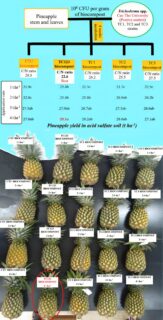Efficacy of biocompost from pineapple waste coupled with indigenous fungi strains Trichoderma spp. on soil fertility, nutrients uptake, growth, and yield of Ananas comosus (L.) Merr
Authors
-
Nguyen Quoc Khuong
 1
1
- Truong Thi Kim Chung 1
- Le Thi My Thu 1
- Tran Chi Nhan 2
- Lieu Mong Ca 1
- Le Thanh Quang 1
- Ly Ngoc Thanh Xuan 2
- Ngo Thanh Phong * 3
Abstract
Purpose: The current study aimed to figure out the types and dosages of biocomposts supplied with cellulose-degrading Trichoderma strains for ameliorating soil properties, and the growth and yield of pineapple.
Method: The experiment with two factors followed a completely randomized block design, including 20 treatments (4 replications). The first factor (A) was the types of biocomposts inoculated with different Trichoderma spp., which were (i) the biocompost supplied with the commercial Trichoderma (the Trichoderma of Can Tho University) as the positive control treatment, and the biocompost supplied with Trichoderma strains of (ii) TC1 (TC1 biocompost), (iii) TC2 (TC2 biocompost), (iv) TC3 (TC3 biocompost), and (v) TC1, TC2, and TC3 (TC123 biocompost). The second factor (B) was rates of bio-compost used (t ha-1) as follows: (i) 1, (ii) 2, (iii) 3, and (iv) 4.
Results: The application of TC123 bio-compost at 4 t ha-1 contributed to the greatest available N, soluble P, concentrations, and N, P, and K uptake values. The treatments with the TC123 biocompost correspondingly increased plant height, leaf number, D-leaf length, peduncle height, fruit length, and fruit width by 1.9, 31.8, 16.7, 5.4, 7.8, and 12.1%, in comparison with the treatments with the positive control. The TC123 biocompost fertilization increased fruit size, resulting in enhanced pineapple yield by 9.80% in comparison with the commercial biocompost fertilization.
Conclusion: The TC123 biocompost surpassed the commercial one in enhancing the characteristics of pineapples (Ananas comosus (L.) Merr). At 4 t.ha-1, this biocompost performed the greatest.




